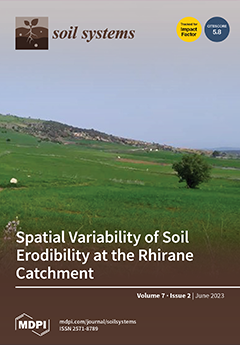Climate changes and poor soil nutrient profiles in sub-tropics are determinant factors to estimate crop productivity. This study aims to evaluate the impact of phytohormones, e.g., indole acetic acid (IAA) and gibberellic acid (GA
3), on mung bean yield, seed nutritional profile, and soil N availability in the sub-tropical region of Pakistan. The mung bean plants were treated with three levels (0, 30, and 60 mg L
−1) of IAA and GA
3 individually and/or in combination using a hydraulic sprayer. The amendments were applied in the flowering stage (approximately 25 days after germination) in a randomized complete block design. The results revealed that the 60 mg L
−1 concentration of IAA and GA
3 led to significant changes in the growth and yield traits compared to non-treated plants. For example, GA
3 positively influenced the biological yield (35.0%), total carbohydrate (7.0%), protein (16.0%), and nitrogen (14.0%) contents in mung bean seeds, compared to the control (CK). Additionally, the combined foliar treatment of IAA and GA
3 (IAA
2 + GA
2) displayed a much stronger influence on yield attributes, such as the number of pods by 66.0%, pods’ weights by 142.0%, and seed yield by 106.5%, compared with the CK. Mung bean plants showed a significant improvement in leaf photosynthetic pigments under a higher level (60 mg L
−1) of sole and combined treatments of IAA and GA
3. Moreover, except abscisic acid, the endogenous concentration of IAA, GA
3, and zeatin was enhanced by 193.0%, 67.0%, and 175.0% after the combined application of IAA and GA
3 (IAA
2 + GA
2) compared to the CK treatment. In addition, soil N availability was increased by 72.8% under the IAA
2 treatment and 61.5% under IAA
2 + GA
2, respectively, compared with the control plot. It was concluded that the combined treatment of IAA and GA
3 (IAA
2 + GA
2) followed by the sole application of GA
3 and IAA at a 60 mg L
−1 concentration were most effective treatments to improve the morpho-physiology and nutrient profile of mung beans; however, the underlying molecular mechanisms need to be explored further.
Full article





